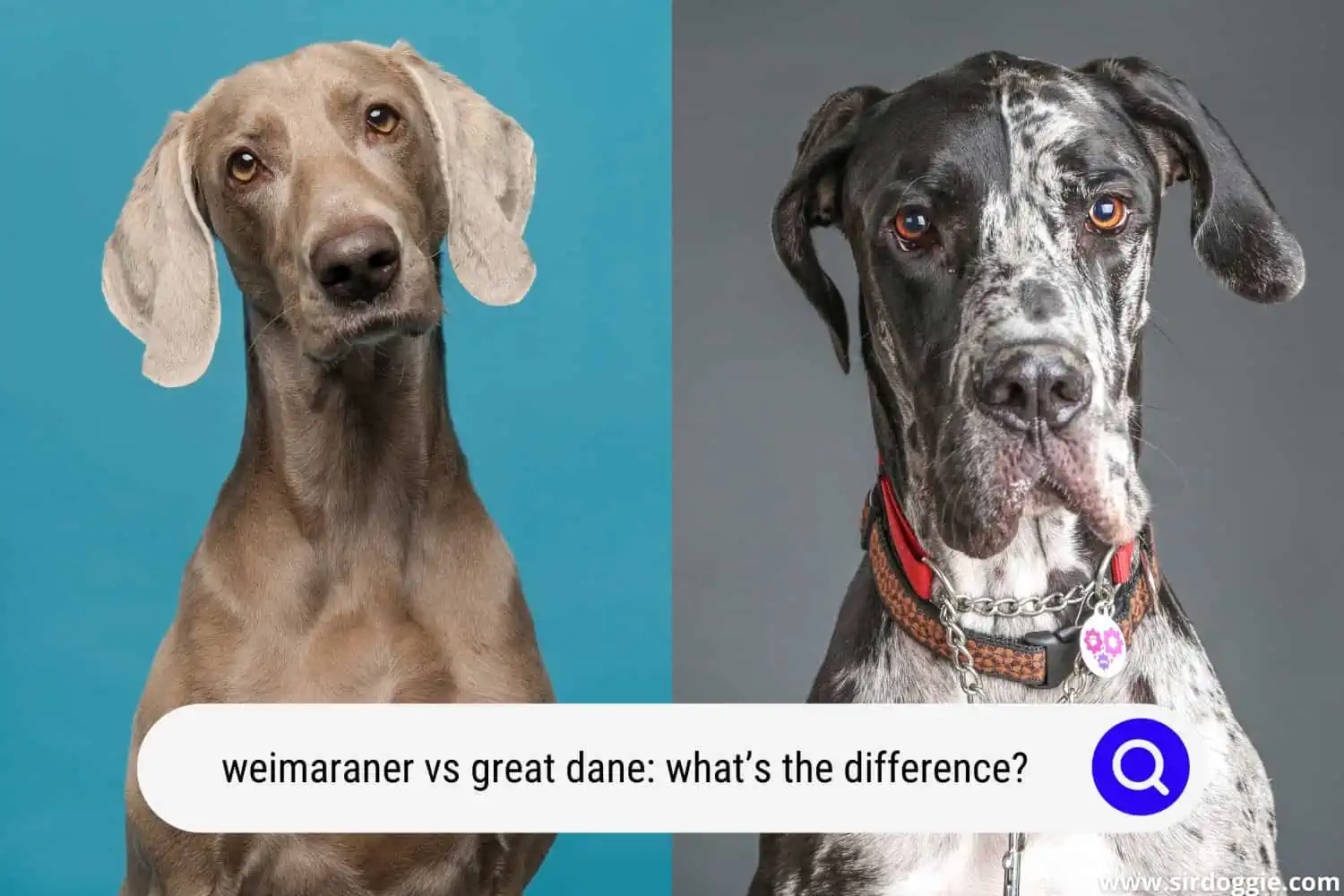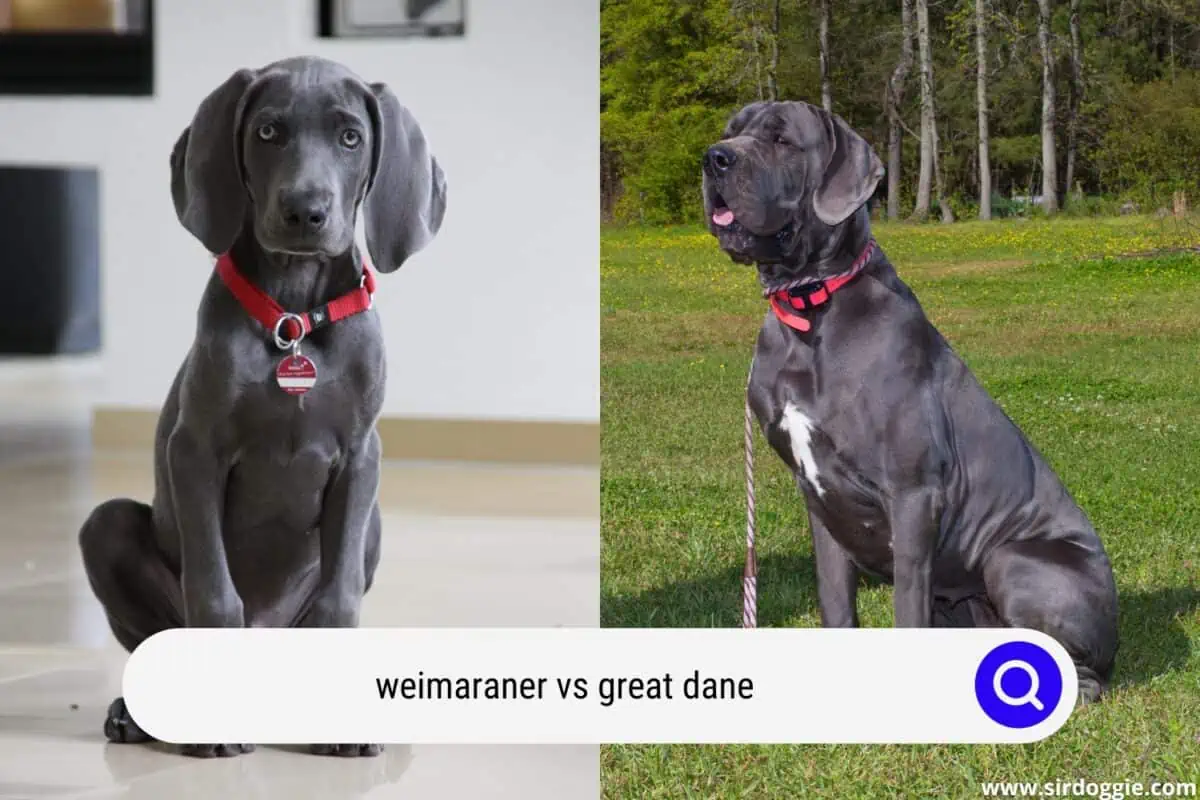Weimaraner vs Great Dane: What’s the Difference?
The Great Dane also called the German mastiff, and the Weimaraner, are two large-sized dogs with adorable characteristics and similarities as well. With both bred in Germany, they are shorthaired dogs with little health concerns. Both are not prone to obesity and have a lifespan of 9 to 14 years.

However, they have quite a lot of differences in characteristics. In this Weimaraner vs Great Dane comparison, we will analyze both dogs individually in terms of their history, characteristics, health, dietary needs, and general care.
About the Great Dane Dog Breed
The Great Dane, or German Mastiff, is one of the largest dogs in the world. Nicknamed “the Apollo of the canine breeds”, this great mastiff with a dissuasive physique at first glance shows great kindness and great tenderness towards his masters and particularly towards children. The Great Dane is a large, formidable, pacific, companion dog overflowing with gentleness and elegance.
History of the Great Dane Dog
Although the German mastiff is also called the Great Dane, it is not from Denmark. Indeed, its origins are German but the breed was very widespread in Denmark.
This great mastiff descended from the Alans. Allans are dogs who accompanied the Alans, nomadic horsemen of Iranian origin, during their conquest of Europe from the 4th to the 6th century. At the end of the Middle Ages, these dogs were recognized for their ability to hunt with hounds and especially wild boar.
The Great Dane was made from numerous crosses of mastiffs. Its most recent ancestor is the Bullenbeisser, an intermediary between a powerful English type Mastiff and a fast Greyhound. It was not until 1878 that its breeding really started.
Great Dane: Physical characteristics
The dog is nicknamed “the Apollo of the canine breeds” because of its appearance which resembles that of a statue full of nobility. The Great Dane combines pride, strength, and elegance.
The skull is narrow and the nose is black. Its very expressive head is carried high. The almond eyes are medium in size and dark. Its ears are drooping and glued to the cheek, the tail set high and wide joins the hock. The back is short, the chest goes down to the level of the elbows, and the loins are wide and slightly curved.
The male measures a minimum of 80 cm and up to 90 cm. The female measures 72 cm to 84 cm. The dogs weigh around 50 to 70 kg. Its coat is very short, dense, smooth, shiny, and flat.
It can have a fawn color with a black mask, steel blue, black lacquer, fawn brindle (gold or light background, black stripes), and harlequin (white background, black spots with jagged outline).
Great Dane: Character and Personality
This very large dog is particularly easygoing, gentle, and affectionate with its owners and particularly with the children it naturally protects. The Great Dane is very attached to its masters and has a real passion for them.
Loyal and courageous, it is a very good deterrent watchdog simply because of its physique. The dog does not need to be aggressive to put any intruders to flight. The Great Dane is a very receptive and obedient dog, which learns quickly and has a very sociable nature.
However, it is very suspicious of strangers but devoid of any aggression. Cohabitation with other animals is no problem.
The Great Dane is one of the best guard dogs in the world thanks to its dissuasive physique, its natural distrust of strangers, and its extreme loyalty to its owners. It is an excellent companion dog for the family and guardian of the property.
Great Dane Health
The Great Dane is a robust dog but its growth and nutritional needs must be particularly monitored when it is a puppy and at least until the age of one year.
The Great Dane grows very quickly and needs a suitable diet, which must be changed often. As an adult, the Great Dane is robust but sensitive to the cold.
Like all large dogs, and even more so for this “giant”, it can be prone to hip dysplasia and it is therefore advisable to choose a puppy whose parents are free from it. Good breeding will rule out the subjects concerned. So pay attention to the origin of the puppy!
The average life expectancy of the Great Dane is 9 years.
What is a Great Dane Dog suitable for?
The Great Dane takes pleasure in watching large properties. However, it can live in an apartment as long as it is taken out several times a day. The Great Dane is not a great athlete and its exercise requirements are normal for dog breeds.
About the Weimaraner Dog Breed
The Weimaraner is a star in the United States. The noble gray fur and the amber-colored eyes make the Weimaraner unique. The relatively young breed of hunting dogs from Germany is increasingly finding its way into family homes. At birth, the Weimi puppies still have black tiger stripes on their fur, which disappear after a few days.
The eyes of young Weimaraners are blue, initially, but the color changes to a shade of brown with age. Since the Weimaraners were bred to hunt game, they are among the fastest dogs with a top speed of 55 kilometers per hour.
History of the Weimaraner
In general, little is known about the ancestors of the Weimaraner. Initially, the breed was rare and known locally around the city of Weimar in Thuringia. Here hunters and foresters bred the beautiful hunting dogs.
It is documented that Grand Duke Karl August of Saxe-Weimar-Eisenach kept some silver hunting dogs at his court in Weimar as early as the beginning of the 19th century.
The breeders of that time did not yet attach great importance to uniform appearance and there were also long-haired alternatives, which are rather rare today. It was not until 1897 that the Weimaraner Klub e. V. documented the silver-gray dog according to a uniform standard.
Since the studbook was entered, the breeders have not crossed any foreign breeds and the Weimaraner is the oldest German dog breed. In the United States, President Dwight Eisenhower made the breed increasingly popular in the 1950s. He owned a Weimaraner named Heidi.
The Americans breed the dog mainly for appearance and because it’s a good family dog. Because of its classy appearance, more and more people want to keep a Weimaraner as a family dog.
Weimaraner Physical characteristics
The Weimaraner is a medium or large-sized dog. It can range between 57 and 70 centimeters in height and weighs around 40kg. They need a lot of physical and mental exercise, as they are very athletic and intelligent.
They have a great hunting instinct that comes out easily. If you have one, you will discover that they love tracking games, the ball, or toys. Activities like agility or swimming are perfect for them as they will help them channel their daily energy.
Character of the Weimaraner
The Weimaraner is an extremely intelligent and confident hunting dog with high predatory sharpness. This means that it will track down and kill games on command. The dogs are suspicious of strangers and need a certain amount of time to get warm to new people.
The protective instinct is very strong and the self-confident dog does not hesitate for a second to defend its family or territory. Even so, it does not have an excessive temper.
The hunting dog is very affectionate and, with a good upbringing, can become a great partner for life. In general, you shouldn’t leave the Weimi alone for long, as it gets nervous and barks.
Weimaraner Care and Health
The hunting dog’s short, shiny coat does not require any special care. It is completely sufficient if you groom it regularly. The long-haired types of the breed should of course get a little more grooming. The dog’s diet should be adapted to its sporting activity and not be too fatty.
The dogs also tend to gobble up their food too quickly, which can cause stomach torsion. So it’s better to feed them small portions several times a day and avoid sporting activities after eating.
In terms of health, the Weimaraner is generally a robust breed with a life expectancy of 10 to 14 years. One of its most-known hereditary diseases is hip dysplasia, which is why you should take a close look at the parent animals when buying.

What are Weimaraner Dogs suitable for?
First and foremost, the Weimaraner is a pure hunting dog that wants to be used accordingly. For this reason, registered breeders of the Weimaraner Klub eV give their puppies preferably to hunters and foresters. However, if you give it enough exercise, it can be happy as a family dog even without hunting.
Comparison Table
| WEIMARANER | GREAT DANE | |
| Breed information | ||
| Lifespan | 13-14 years | 9-10 years |
| Size | Large | Giant |
| Availability | A bit easy to get | A bit rare |
| Activity requirement | Energy bundle | Not a couch potato |
| Maintenance and care | ||
| Drooling | No | Yes |
| Bath | Rare | Rare |
| Exercise | Heavy exercise | Regular exercise |
| Food expenditure | Moderate | Very high |
| Grooming needs | Medium | Low |
| Cold tolerance | Loves snow | Needs warmth |
| Health | ||
| Obesity | No | No |
| Veterinary visits | Rare | Rare |
Conclusion
While the Weimaraner requires moderate feeding, as for all very large dogs and in this case the Great Dane, you have to be aware that their food needs to command a significant budget that you must be able to meet for about 9 years. Veterinary care is rare but high and commands a high budget, especially during its growth period.
The Weimaraner doesn’t tolerate cold while the Great Dane does. Overall, it’s hard to say which is the better dog in this Weimaraner vs Great Dane comparison. Your lifestyle, location, needs, etc. will determine which is the best for you among the two.

Family Dog Expert Author
Hi there! I’m Stuart, a devoted dog lover and family dog expert with over a decade of experience working with our furry companions. My passion for dogs drives me to share my knowledge and expertise, helping families build strong, loving bonds with their four-legged friends. When I’m not writing for SirDoggie, you’ll find me hiking, playing with my beautiful dog, or studying music.